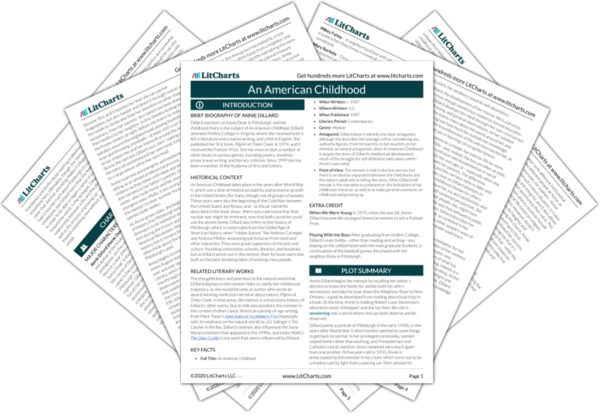The Interior Life
As a chronicle of her childhood, Annie Dillard’s memoir focuses far less on detailing a progression of socially important milestones than on her intellectual development—on the life of the mind. The “interior life” is a phrase repeated throughout the book to describe Annie’s fascination with her own mind, which she usually finds more important and interesting than external events. While Dillard relishes the joy she derives from her interior life, as she narrates from her…
read analysis of The Interior LifeCuriosity and Attention
It becomes almost immediately apparent in An American Childhood that the protagonist is someone with an unusual capacity for attention and observation—a capacity that is fueled by her peculiar and insatiable curiosity. For Dillard, this curiosity is central to intellectual development, because it is its own, self-sufficient motivation to learn, observe, and explore.
Dillard recalls her childhood fascination with Arthur Conan Doyle’s books about Sherlock Holmes; she modeled herself after the detective, looking for…
read analysis of Curiosity and AttentionFamily, Authority, and Institutions
Even if the real drama of Annie’s growing up takes place within her own mind, most of her external drama has to do with her relationship to authority. Annie’s curiosity means that she’s a uniquely self-propelled child, but the flip side of her independence is that the institutions and authority figures that lend structure to her childhood irritate her and become sources of tension between her own desires and her institutional obligations.
This tension begins…
read analysis of Family, Authority, and Institutions
Place and Environment
At the end of An American Childhood, Dillard constructs a kind of thought experiment, asking the reader to imagine how personal memories are tied to a certain place—and how one must accept and trust that these vivid memories are not only beloved imaginative possessions, but also part of a larger world we all share. The sense of responsibility for the environment that stems from this argument is key to Dillard’s ethics, and in her…
read analysis of Place and Environment






